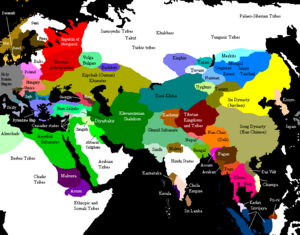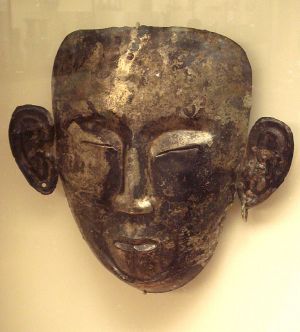Difference between revisions of "Kara-Khitan Khanate" - New World Encyclopedia
Dan Davies (talk | contribs) (started, images OK) |
({{Contracted}}) |
||
| Line 1: | Line 1: | ||
| − | {{images OK}}{{started}}{{claimed}} | + | {{images OK}}{{started}}{{claimed}}{{Contracted}} |
:''This article refers to the [[Khitan people|Khitan]] [[Khanate]]. For the Turkic state, see [[Kara-Khanid Khanate]].'' | :''This article refers to the [[Khitan people|Khitan]] [[Khanate]]. For the Turkic state, see [[Kara-Khanid Khanate]].'' | ||
[[Image:Premongol.png|thumb|Map of Asia and Europe circa 1200 C.E.]] | [[Image:Premongol.png|thumb|Map of Asia and Europe circa 1200 C.E.]] | ||
Revision as of 22:04, 5 October 2007
- This article refers to the Khitan Khanate. For the Turkic state, see Kara-Khanid Khanate.
The Kara-Khitan Khanate, or Western Liao (Mongolian Хар Хятад; Kara Kitad; Traditional Chinese: 西遼; Simplified Chinese: 西辽; pinyin: Xī Liáo, 1124[1]-1218) was a Khitan empire in Central Asia. The dynasty was founded by Yelü Dashi, who led the remnants of the Liao Dynasty to Central Asia after fleeing from the Jurchen conquest of their homeland in Manchuria. The empire was usurped by the Naimans under Kuchlug in 1211; traditional Chinese, Persian and Arab sources consider the usurption to be the end of the empire.[2] The empire was destroyed by the Mongol Empire in 1218.
Names
Kara Khitan (Hala Qidan) was the name used by the Khitans to refer to themselves. The phrase is often translated as the Black Khitans, but its original meaning is unclear today.[3] Since no direct records from the empire survive today, the only surviving historical records about the empire come from outside sources. Since the empire took on trappings of a Chinese state, Chinese historians generally refer to the empire as the Western Liao Dynasty, emphasizing its continuation from the Liao Dynasty in Manchuria. The Jurchens referred to the empire as Dashi or Dashi Linya (after its founder), to reduce any claims the empire may have had to the old territories of the Liao Dynasty. Muslim historians initially referred to the state simply as Khitay or Khitai. It was only after the Mongol conquest that the state began to be referred to in the Muslim world as the Kara-Khitai or Qara-Khitai.[4]
Administration
The Khitans ruled from their capital at Balasagun (in today's Kyrgyzstan). They directly controlled the central region of the empire. The rest of their empire consisted of highly-autonomous vassalized states, primarily Khwarezm, the Karluks, the Gaochang Uyghurs, the Qangli and the Western, Eastern and Fergana Kara-Khanids. The late-arriving Naimans also became vassals, before usurping the empire under Kuchlug.
The Khitan rulers adopted many administrative elements from the Liao Dynasty, including the use of Confucian administration and imperial trappings. The empire also adopted the title of Gurkhan (universal Khan).[5] The Khitans used the Chinese calendar, maintained Chinese imperial and administrative titles, gave its emperors reign names, used Chinese-styled coins, and sent imperial seals to its vassals.[6] Although most of its administrative titles were derived from Chinese, the empire also adopted local administrative titles, such as tayangyu (Turkic) and vizier.
The Khitans maintained their old customs, even in Central Asia. They remained nomads, adhered to their traditional dress and maintained the religious practices followed by the Liao Dynasty Khitans. The ruling elite tried to maintain the traditional marriages between the Yelü royal clan and the Xiao consort clan, and were highly reluctant to allow their princesses to marry outsiders. The Kara-Khitai Khitans followed a mix of Buddhism and traditional Khitan religion, which included fire worship and tribal customs, such as the tradition of sacrificing a gray ox with a white horse. In an innovation unique to the Kara-Khitai, the Khitans paid their soldiers a salary.
The empire ruled over a diverse population that was quite different from its rulers. The majority of the population was sedentary, although the population suddenly became more nomadic during the end of the empire, due to the influx of Naimans. The majority of their subjects were Muslims, although a significant minority practiced Buddhism and Nestorianism. Although Chinese and Khitan were the primary languages of administration, the empire also administered in Persian and Uyghur.[7]
History
The Kara-Khitai empire was established by Yelü Dashi, who led 100,000 Khitans into Central Asia from Manchuria by way of Mongolia. Yelü conquered Balasagun from the Kara-Khanid Khanate in 1134, which marks the start of the empire in Central Asia. The Khitan forces were soon joined by 10,000 Khitans, who had been subjects of the Kara-Khanid Khanate. The Khitans then conquered Kashgar, Khotan, and Besh Baliq. The Khitans defeated the Western Kara-Khanid Khanate at Khujand in 1137, eventually leading to their control over the Fergana Valley. They won the Battle of Qatwan against the Western Kara-Khanids in September 9, 1141, which allowed the Khitans to control Transoxania and forced Khwarezm to become their vassals.
Yelü soon died in 1143, and was followed by his wife, Xiao Tabuyan, as regent for their son. Their son, Yelü Yiliu, died in 1163 and was succeeded by his sister, Yelü Pusuwan. She sent her husband, Xiao Duolubu, on many military campaigns. She then fell in love with his younger brother, Xiao Fuguzhi. They were executed in 1177 by her father-in-law, Xiao Wolila, who then placed Yelü Zhilugu on the throne in 1178. The empire was weakened by rebellions and internal wars among its vassals, especially during the latter parts of its history. In 1208, the Naimans fled from their homeland and were welcomed into the empire of the Kara-Khitai. In 1211, the Naiman prince, Kuchlug, captured Yelü Zhilugu while the latter was hunting, ending Khitan rule in the Kara-Khitai empire. The Mongols captured and killed Kuchlug in 1218. The Mongols fully conquered the former territories of the Kara-Khitai in 1220.
Sovereigns of Kara-Khitan Khanate
| Temple Names ( Miao Hao 廟號 miàohào) | Posthumous Names ( Shi Hao 諡號 shìhào) | Birth Names | Convention | Period of Reign | Era Names (Nian Hao 年號 niánhào) and their according range of years |
|---|---|---|---|---|---|
| Convention: check each sovereign | |||||
| Dezong (德宗 Dézōng) | Tianyouwuliedi (天祐武烈帝 Tiānyòuwǔlièdì) | Yelü Dashi (耶律大石 Yēlǜ Dàshí or 耶律達實 Yēlǜ Dáshí) 1 | use born name | 1124-1144 | Yanqing (延慶 Yánqìng) 1124 or 1125-1134 Kangguo (康國 Kāngguó) 1134-1144 |
| Did not exist | Gantianhou (感天后 Gǎntiānhòu) | Tabuyan (塔不煙 Tǎbùyān) | "Xi Liao" + posthumous name | 1144-1150 | Xianqing (咸清 Xiánqīng) 1144-1150 |
| Emperor Renzong of Western Liao (仁宗 Rénzōng) | Too tedious thus not used when referring to this sovereign | Yelü Yilie (耶律夷列 Yēlǜ Yíliè) | "Xi Liao" + temple name | 1150-1164 | Shaoxing (紹興 Shàoxīng) 1150-1164 |
| Did not exist | Chengtianhou (承天后 Chéngtiānhòu) | Yelü Pusuwan (耶律普速完 Yēlǜ Pǔsùwán) | "Xi Liao" + posthumous name | 1164-1178 | Chongfu (崇福 Chóngfú) 1164-1178 |
| Did not exist | Mozhu (末主 Mòzhǔ) or Modi (末帝 Mòdì) | Yelü Zhilugu (耶律直魯古 Yēlǜ Zhílǔgǔ) | use born name | 1178-1211 | Tianxi (天禧 Tiānxī) 1178-1211 |
| Did not exist | Did not exist | Kuchlug (Ch. 屈出律 Qūchūlǜ) | use born name | 1211-1218 | Did not exist |
| 1 "Dashi" might be the Chinese title "Taishi," meaning "vizier"; Or it could mean "Stone" in Turkish, as the Chinese transliteration suggests | |||||
See also
- Buraq Hajib
- Kara-Khanid Khanate
Notes
- ↑ 1124 is the year in which Yelü Dashi proclaimed himself king, while still in Mongolia
- ↑ The Empire of the Qara Khitai in Eurasian History: Between China and the Islamic World, pp. 2
- ↑ The Empire of the Qara Khitai in Eurasian History: Between China and the Islamic World, pp. 216-217
- ↑ The Empire of the Qara Khitai in Eurasian History: Between China and the Islamic World, pp. 215-217
- ↑ Gurkhan was probably a title originating from Central Asian nomads, The Empire of the Qara Khitai in Eurasian History: Between China and the Islamic World, pp. 1
- ↑ The Empire of the Qara Khitai in Eurasian History: Between China and the Islamic World, pp. 93-131
- ↑ The Empire of the Qara Khitai in Eurasian History: Between China and the Islamic World, pp. 94
ReferencesISBN links support NWE through referral fees
- Biran, Michal. The Empire of the Qara Khitai in Eurasian History: Between China and the Islamic World, ISBN 0521842263
Credits
New World Encyclopedia writers and editors rewrote and completed the Wikipedia article in accordance with New World Encyclopedia standards. This article abides by terms of the Creative Commons CC-by-sa 3.0 License (CC-by-sa), which may be used and disseminated with proper attribution. Credit is due under the terms of this license that can reference both the New World Encyclopedia contributors and the selfless volunteer contributors of the Wikimedia Foundation. To cite this article click here for a list of acceptable citing formats.The history of earlier contributions by wikipedians is accessible to researchers here:
The history of this article since it was imported to New World Encyclopedia:
Note: Some restrictions may apply to use of individual images which are separately licensed.

